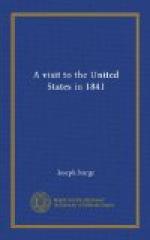In subsequent anti-slavery meetings in Boston, New York, and elsewhere, it became manifest that there was a radical difference of opinion on the subject of political action; the non-resistant and no-government influence, operating decidedly against the employment of the elective franchise in the anti-slavery cause; and the agitation of this question, as well as that of the rights of women, in their meetings, gave to them a discordant and party character, painfully contrasting with the previous peaceful and harmonious action of the societies. That some of both parties began to overlook the great subject of the slaves’ emancipation, in zealous advocacy of, or opposition to, these new measures, I cannot well doubt, judging from the testimony of those, who, not fully sympathizing with either, endeavored to bring all back to the single object of the anti-slavery association. In addition to these intestine troubles, the pro-slavery party made strenuous exertions to fasten upon the society the responsibility of the opinions and proceedings of its non-resistant and no-government members. Under these circumstances it is easy to understand the interruption, for a season, of the unity of feeling and action which had previously characterized the assemblies of the abolitionists. The actual separation in the societies took place in the Spring of 1840. The members of the executive committee at New York, with one exception, seceded and became members of the committee of the “new organization,” under the name of the “American and Foreign Anti-Slavery Society.” There are, therefore, now two central or national anti-slavery societies; the “old organization,” retaining the designation of the “American Anti-Slavery Society.” The State Societies have, for the most part, taken up a position of neutrality, or independence of both. It is important to add that the division took place on the “women’s rights” question, and that this is the only one of the controverted points which the American Anti-Slavery Society has officially affirmed; and it is argued, on behalf of their view of this question, that since, in the original “constitution” of the society, the term, describing its members, officers, et cet., is “persons,” that women are plainly invested with the same eligibility to appointments, and the same right to vote and act as the other sex. I need not say how this “constitutional” argument is met on the other side. The other new views are held by comparatively few persons, and neither anti-slavery society in America is responsible for them. In conclusion, I rejoice to be able to add, that the separation, in its effects, appears to have been a healing measure; a better and kinder feeling is beginning to pervade all classes of American abolitionists; the day of mutual crimination seems to be passing away, and there is strong reason to hope that the action of the respective societies will henceforward harmoniously tend to the same object. That such may be the result is my sincere desire. It is proper in this connection to state that a considerable number of active and prominent abolitionists do not entirely sympathize with either division of the anti-slavery society; and there are comparatively few who make their views, for or against the question on which the division took place, a matter of conscience.




